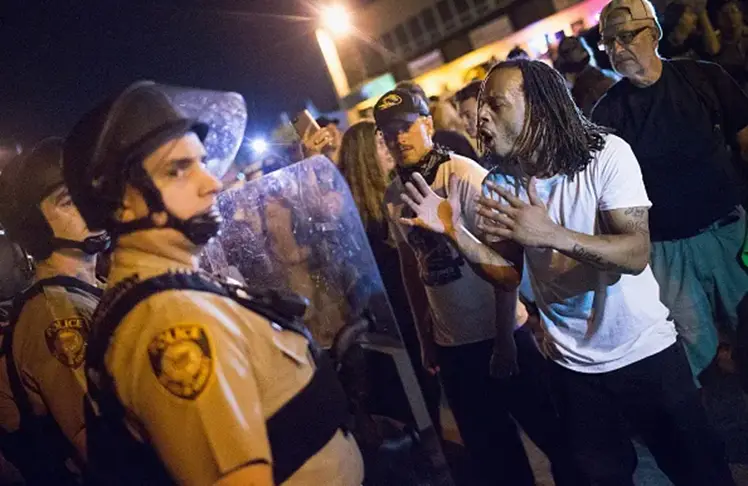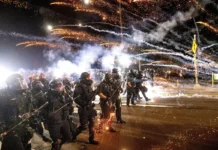
When Zellie Imani first arrived on the streets of Ferguson, Missouri, a decade ago — not long after a white cop killed Michael Brown, an unarmed teenager — the first thing he noticed was the tension beneath the calm.
Imani, a schoolteacher and community organizer, arrived on the scene from New Jersey to join the front-line ranks of the protesters, angry that yet another defenseless Black person had lost their life at the hands of police. In the rising heat of a late summer morning, he saw militarized police — batons and riot shields out, assault weapons and armored vehicles deployed — and angry demonstrators warily eyeing one another in an uneasy truce.
“People were just standing around, milling around,” Imani says, recalling that day in August 2014, not long after the community exploded in anger and frustration at Brown’s senseless death. Heavy-handed police had put a lid on things, but only for the moment.
“Everyone knew that it turns up at night,” Imani says.
Friday marks the 10th anniversary of Brown’s killing, a horrific incident that sparked months of nightly demonstrations that put a spotlight on unjustified use of deadly force against Black people. It also catapulted the #BlackLivesMatter movement to the top of the national agenda and forced a long-overdue conversation on systemic racism in America.
And while police killings haven’t stopped — at least four other high-profile cases, including the killing of George Floyd, happened after former Ferguson officer Darren WIlson shot Michael Brown — several officers have faced consequences for their actions. That includes Derek Chauvin, who is serving 21 years in prison for Floyd’s death.
By the time the Ferguson protests ended, the Justice Department launched an investigation that would reveal decades of injustice and racist practices by the Ferguson city government. That included gerrymandering that stunted Black representation on the city council, racial bias and poor screening in police department hiring practices, and law-enforcement tactics that targeted Black motorists for minor traffic violations, bringing in revenue for the city.
If you were Black and driving through Ferguson, “you had to make sure that your tail lights worked, your headlights worked, your plates were registered correctly, you didn’t speed because you were going to be a target,” Troy Doyle, Ferguson’s police chief, told National Public Radio in an interview broadcast on Wednesday.
Doyle, who is Black and grew up in the area and is the city’s second Black police chief. The first, Delrish Moss, came into office in 2016 after a series of reforms that overhauled the police department. Those reforms helped Black residents elect two Black members to the Ferguson city council and ushered in the city’s first Black mayor, Ella Jones, in 2020.
Those gains, however, likely were unimaginable to Imani, the New Jersey school teacher who came to Ferguson to help organize protests
Faaa was just after Brown’s death. For the next few weeks, he and his comrades spent days organizing protests over Brown’s death and nights dodging police firing teargas canisters and rubber bullets — a risky, violent, potentially deadly cat-and-mouse game.
On the street that first day, Imani knew that all hell would break loose after sunset — and he was right.
“That’s what I experienced on that first night,” he says. “We stayed out and we were engaging in protest. I remember, vividly, a group of young men who were shirtless. They had their shirts wrapped around their mouths, because that was the only way they could protect themselves from being tear gassed, because they knew they were going to get tear gassed again.”
He goes on: “There was a clergy member who was begging them to go home and they told the clergy person, ‘Don’t tell us to go home so we don’t get killed because they’re out here killing us anyway.”
So it went for the next few weeks, with Imani dodging teargas canisters and rubber bullets from police he says were “shooting indiscriminately into the crowd” — even if no one had assaulted them first. “It just really showed me the violence that police are willing to administer.”
When the protests subsided and the school year approached, Imani returned to New Jersey and life moved on. Meanwhile, the grim drumbeat of police killing Black people under dubious circumstances goes on: Floyd, Philando Castile, Breanna Taylor, Daunte Wright, now Sonya Massey, shot in her home in southern Illinois last month.
But Imani says the protests he joined in Ferguson that hot August week have made a clear difference in the conversation around race and policing.
“In my generation, talking about race was a taboo thing,” he says. “People would say you’re playing the race card. So even trying to talk about racism or police violence, you were being constantly silenced and gaslit. But because of what happened in Ferguson and everything else, the discussion of race and discourse of race became a new part of our culture.”
At the same time, “you do see changes in the way that people are talking about policing,” Imani says. “People are just not focusing on, ‘Oh, we need more training,’ or ‘We need body cameras.’ People are moving more into the conversations about, ‘Hey, maybe police officers shouldn’t be the ones to respond when someone is going through a mental health crisis.’”
“Things are changing,” he says. “Not at the pace that we want to change, obviously, but things are evolving.”















